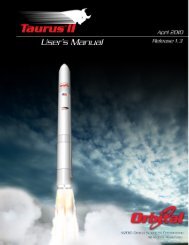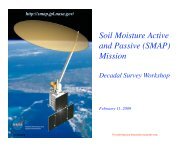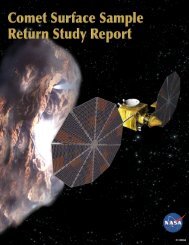Orbital Debris - NASA Earth Science Decadal Survey Studies
Orbital Debris - NASA Earth Science Decadal Survey Studies
Orbital Debris - NASA Earth Science Decadal Survey Studies
Create successful ePaper yourself
Turn your PDF publications into a flip-book with our unique Google optimized e-Paper software.
I n t e g r a t e d D e s i g n C e n t e r / M I s s I o n D e s I g n L a b o r a t o r yPACE 2012<strong>Orbital</strong> <strong>Debris</strong> and End of Mission Plans14 – 18 May, 2012Do not distribute this information without permissionfrom Betsy Edwards/<strong>NASA</strong>-HQ (betsy.edwards@nasa.gov)N A S A G O D D A R D S P A C E F L I G H T C E N T E R
Atmospheric Reentry RequirementsM i s s i o n D e s i g n L a b o r a t o r y• The risk to human casualty on ground from surviving componentsdepends on:• The total <strong>Debris</strong> Casualty Area (DCA) of surviving components.• Average population density at the corresponding orbital inclination onthe predicted reentry date if left uncontrolled (“Population density” forthe purpose of this study).• In base of the above, the risk to human life is calculated. <strong>NASA</strong> andinternational agreements limit the risk to 1:10,000.* DCA= Maximum cross-sectional area of surviving part plus a factor to account for the cross-sectional area ofa standing person.14 – 18 May, 2012PACE 2012Do not distribute this information without permissionfrom Betsy Edwards/<strong>NASA</strong>-HQ (betsy.edwards@nasa.gov)<strong>Orbital</strong> <strong>Debris</strong>, p3Final Version
Other Disposal Requirements toConsiderM i s s i o n D e s i g n L a b o r a t o r yUpdated requirement, per <strong>NASA</strong>-STD-8719.14 Revision A:• If risk to human life > 0.0001 (1:10,000), then controlled reentry must be performed and theprobability of failure of the reentry burn must be included in the risk calculation:Risk of human casualty = DCA x Population density x Probability of failure of reentry burn• The Probability of failure (P f ) of reentry burn can not exceed 0.10 per Requirement 4.6-4.a.<strong>Debris</strong>CasualtyArea(m2)14 – 18 May, 2012PACE 2012Probabilityof failure ofreentry burn Reliability8 0.946305 0.0536959 0.841160 0.15884010 0.757044 0.24295611 0.688222 0.31177812 0.630870 0.36913013 0.582342 0.41765814 0.540746 0.45925415 0.504696 0.49530416 0.473153 0.52684717 0.445320 0.55468018 0.420580 0.57942019 0.398444 0.60155620 0.378522 0.621478• Per Req. 4.6-4.b, for a DCA = 11 m 2 , the maximumProbability of Success (Reliability) is 0.3118, which is lessthan 0.90. For this reason, the limit imposed by Req. 4.6-4.b takes precedence, and the minimum Probability ofSuccess = 0.90.Do not distribute this information without permissionfrom Betsy Edwards/<strong>NASA</strong>-HQ (betsy.edwards@nasa.gov)<strong>Orbital</strong> <strong>Debris</strong>, p5Final Version
Conclusions14 – 18 May, 2012PACE 2012M i s s i o n D e s i g n L a b o r a t o r y• Spacecraft is noncompliant for uncontrolled reentry.– <strong>Orbital</strong> lifetime > 25 yrs.– Risk to human life > 1:10,000 of significant injury to humans on ground.• The use of controlled reentry to 50 x 700 km allows compliance withthe requirements to limit the spacecraft orbital lifetime (Req. 4.6-1.a)and to limit the risk to humans on ground (Req. 4.7-1.a and .c).– The worst-case scenario shows a risk to human life on ground due to objectssurviving reentry of 1:8,000 (limit 1:10,000), with a DCA = 11.09 m 2 .• 39% of the DCA is from the bus, 61% is from the OCE2 instrument.• The Polarimeter has not been included in the analysis because of lack of data. Final DCAmay be higher once this instrument is analyzed.– Any DCA ≥ 8 m 2 results in non-compliance with the 1:10,000 limit.• The use of demisable tanks and RWA may reduce the DCA to 6.81 m 2 .• An alternative EOM disposal strategy can be used to significantlyreduce propellant and allow use of a demisable Al tank: controlleddeorbit to 510 x 700 km, followed by uncontrolled reentry (see“Propulsion” charts 13 - 15) for a 1100 kg (dry mass) S/C, DCA will bereduced to 9.3 m 2 , and risk to human injury reduced to 1 in 9,400,getting close to meet the < 1 in 10,000 requirement• To confirm the reentry analysis results, it is recommended to requestan ORSAT (Object Reentry Survival Analysis Tool) analysis from the<strong>Orbital</strong> <strong>Debris</strong> Program Office at JSC.Do not distribute this information without permissionfrom Betsy Edwards/<strong>NASA</strong>-HQ (betsy.edwards@nasa.gov)<strong>Orbital</strong> <strong>Debris</strong>, p6Final Version
AcronymsM i s s i o n D e s i g n L a b o r a t o r y• DCA – <strong>Debris</strong> Casualty Area• EOM – End of Mission• JSC – Johnson Space Center• ORSAT – Object Reentry Survival Analysis Tool• RWA – Reaction Wheel Assembly14 – 18 May, 2012PACE 2012Do not distribute this information without permissionfrom Betsy Edwards/<strong>NASA</strong>-HQ (betsy.edwards@nasa.gov)<strong>Orbital</strong> <strong>Debris</strong>, p7Final Version
M i s s i o n D e s i g n L a b o r a t o r yBACKGROUND SLIDES14 – 18 May, 2012PACE 2012Do not distribute this information without permissionfrom Betsy Edwards/<strong>NASA</strong>-HQ (betsy.edwards@nasa.gov)<strong>Orbital</strong> <strong>Debris</strong>, p8Final Version
M i s s i o n D e s i g n L a b o r a t o r yRequirements List14 – 18 May, 2012PACE 2012Do not distribute this information without permissionfrom Betsy Edwards/<strong>NASA</strong>-HQ (betsy.edwards@nasa.gov)<strong>Orbital</strong> <strong>Debris</strong>, p9Final Version
4.3 Assessment of <strong>Debris</strong> ReleasedDuring Normal OperationsM i s s i o n D e s i g n L a b o r a t o r y14 – 18 May, 2012PACE 2012Do not distribute this information without permissionfrom Betsy Edwards/<strong>NASA</strong>-HQ (betsy.edwards@nasa.gov)<strong>Orbital</strong> <strong>Debris</strong>, p10Final Version
4.4 Assessment of <strong>Debris</strong> Generated byExplosions and Intentional BreakupsM i s s i o n D e s i g n L a b o r a t o r y14 – 18 May, 2012PACE 2012Do not distribute this information without permissionfrom Betsy Edwards/<strong>NASA</strong>-HQ (betsy.edwards@nasa.gov)<strong>Orbital</strong> <strong>Debris</strong>, p11Final Version
4.4 Assessment of <strong>Debris</strong> Generated byExplosions and Intentional Breakups, cont.M i s s i o n D e s i g n L a b o r a t o r y14 – 18 May, 2012PACE 2012Do not distribute this information without permissionfrom Betsy Edwards/<strong>NASA</strong>-HQ (betsy.edwards@nasa.gov)<strong>Orbital</strong> <strong>Debris</strong>, p12Final Version
4.5 Assessment of <strong>Debris</strong> Generatedby On-orbit CollisionsM i s s i o n D e s i g n L a b o r a t o r y14 – 18 May, 2012PACE 2012Do not distribute this information without permissionfrom Betsy Edwards/<strong>NASA</strong>-HQ (betsy.edwards@nasa.gov)<strong>Orbital</strong> <strong>Debris</strong>, p13Final Version
4.6 Postmission Disposal of SpaceStructuresM i s s i o n D e s i g n L a b o r a t o r y14 – 18 May, 2012PACE 2012Do not distribute this information without permissionfrom Betsy Edwards/<strong>NASA</strong>-HQ (betsy.edwards@nasa.gov)<strong>Orbital</strong> <strong>Debris</strong>, p14Final Version
4.6 Postmission Disposal of SpaceStructures, cont.M i s s i o n D e s i g n L a b o r a t o r y14 – 18 May, 2012PACE 2012Do not distribute this information without permissionfrom Betsy Edwards/<strong>NASA</strong>-HQ (betsy.edwards@nasa.gov)<strong>Orbital</strong> <strong>Debris</strong>, p15Final Version
4.7 Survival of <strong>Debris</strong> From the PostmissionDisposal <strong>Earth</strong> Atmospheric Reentry OptionM i s s i o n D e s i g n L a b o r a t o r y14 – 18 May, 2012PACE 2012Do not distribute this information without permissionfrom Betsy Edwards/<strong>NASA</strong>-HQ (betsy.edwards@nasa.gov)<strong>Orbital</strong> <strong>Debris</strong>, p16Final Version
4.8 Additional AssessmentRequirements for Tether MissionsM i s s i o n D e s i g n L a b o r a t o r y14 – 18 May, 2012PACE 2012Do not distribute this information without permissionfrom Betsy Edwards/<strong>NASA</strong>-HQ (betsy.edwards@nasa.gov)<strong>Orbital</strong> <strong>Debris</strong>, p17Final Version





